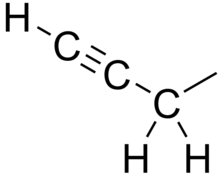Propargyl

Chemical structure of the propargyl group.
In organic chemistry, propargyl is an alkyl functional group of 2-propynyl with the structure HC≡C−CH2−, derived from the alkyne propyne.
The term propargylic refers to a saturated position (sp3-hybridized) on a molecular framework next to an alkynyl group. The name comes from mix of propene and argentum, which refers to the typical reaction of the terminal alkynes with silver salts.
The term homopropargylic designates in the same manner
- a saturated position on a molecular framework next to a propargylic group and thus two bonds from an alkyne moiety.[1]
- a 3-butynyl fragment, HCC-CH2CH2-, or substituted homologue.
See also
- Alkenyl groups
- Ethynyl
- Propargyl chloride
- Propargyl alcohol
- Propargyl bromide
- Propiolic acid
References
- ↑ Ferreira, Franck; Denichoux, Aurélien; Chemla, Fabrice; Bejjani, Joseph (2004). "Highly Diastereoselective Syntheses of Propargylic Acid and Homopropargylic Systems". Synlett (12): 2051–2065. doi:10.1055/s-2004-832816.
This article is issued from Wikipedia - version of the 9/5/2016. The text is available under the Creative Commons Attribution/Share Alike but additional terms may apply for the media files.